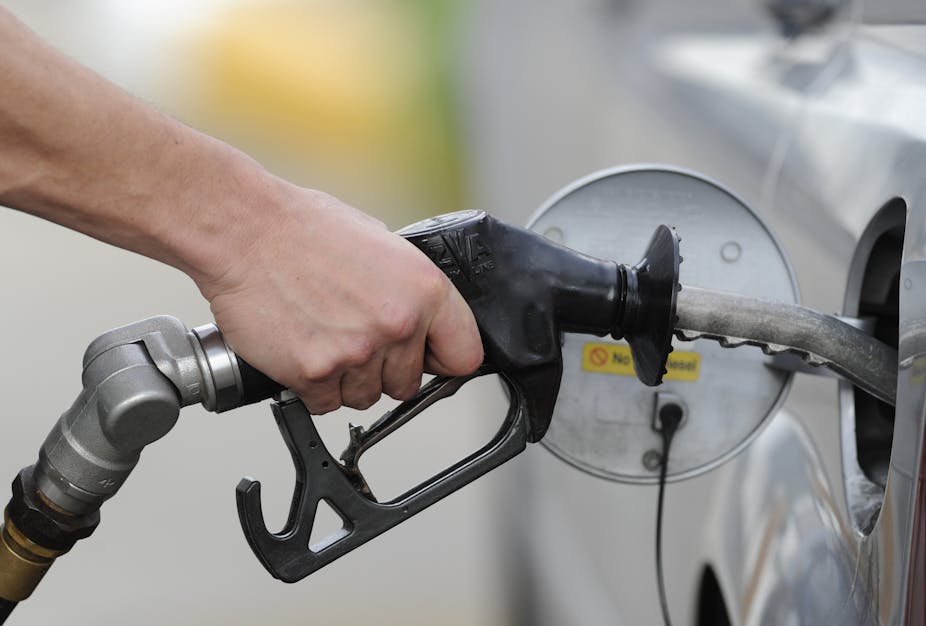In his budget announcement, treasurer Joe Hockey has indicated that the government will increase the fuel excise in line with inflation twice each year.
The excise, currently 38.143 cents per litre, has been in place since John Howard’s Coalition government ditched indexation in 2001 to offset the price hike caused by the introduction of the goods and services tax (GST).
With no increase to the fuel excise in more than a decade, it is now about 39% lower than it would otherwise have been. Put another way, if petrol prices had been pegged to inflation since 2001, we would have been paying an average of about 205 cents per litre by 2013.
It is therefore not surprising that Australia now has some of the lowest petrol prices among the 34 members of the Organization for Economic Cooperation and Development (OECD). In fact, only three OECD countries – Mexico, the United States and Canada – have lower petrol prices than Australia.
Meanwhile, petrol prices in Australia have been on an upward trend since 2002, because of rising international crude oil prices, although domestic fuel prices have risen much more slowly than the price of crude. Global crude oil prices have increased fourfold since 2002, while average petrol prices in Australia have not quite doubled, from 87 cents per litre in 2002 to 148 cents per litre in 2013.
Price increases in Australia have also been cushioned by the growing strength of the Australian dollar against the US dollar, the currency in which most of the world’s oil is traded. The value of the Aussie dollar increased from only 48 US cents in April 2001 – the lowest value ever recorded – to above parity in 2011, before dropping to 90-95 US cents, where it currently stands.
Australian motorists have had an easy ride
Given this analysis, one could argue that Australians have not been affected by petrol price increases as much as motorists in many other developed economies. So while reinstating fuel excise indexation would be an unpopular move, it would be a logical step for a government that is desperate to return the budget to surplus. But what can we expect in the future?
In its 2013 World Energy Outlook, the International Energy Agency forecast that oil prices would stand at US$128 a barrel by 2035. This prediction takes into consideration the increased supply of shale oil, without which the forecast price would be higher.
Other analysts disagree, arguing that the supply of shale oil will be big enough to bring long-term prices as low as US$80 a barrel by 2035.
Predicting future oil prices is a bit like trying to pick a Melbourne Cup winner a decade from now. But that doesn’t mean we can’t make some predictions about domestic fuel prices. If we assume that global oil prices will stay roughly the same for the rest of the decade, then Australian motorists will probably be still be paying more – partly because of the indexed fuel excise, but mainly because the Australian dollar is set to be worth less.
The Aussie dollar lost 13% of its value against the greenback over the past year (although it has recently recouped some of that). Deutsche Bank has predicted that its value will drop as low as 66 US cents before the end of 2015, because of falling commodity prices, declining mining investment, and reduced government spending.
Such a big drop in the value of the Australian dollar would have a much bigger effect on Australian petrol prices than any change to the fuel excise. If Deutsche Bank’s prediction comes true – and if crude oil prices stay roughly the same in the meantime – this would drive Australian petrol prices up by about 29% by the end of next year.
When coupled with an increase in fuel excise at a 3% annual inflation rate, this would mean that average petrol prices will move from their current level of 156 cents per litre to about 208 cents per litre by the end of 2015. But this will mainly be driven by the falling Aussie dollar, while the fuel excise indexation will only add a relatively small amount to the price. If the Australian dollar held firm against the greenback instead of dropping, fuel prices would only climb by 7 cents per litre.
Reintroducing fuel excise indexation will certainly add to the cost of petrol across Australia, and as such it will be politically unpopular. But it is not a major factor of petrol price movements, which will remain largely determined by global crude oil prices and currency fluctuations.
For Australian motorists, who have enjoyed more than a decade’s respite from fuel tax rises, a visit to the bowser is likely to get quite a lot more expensive.

